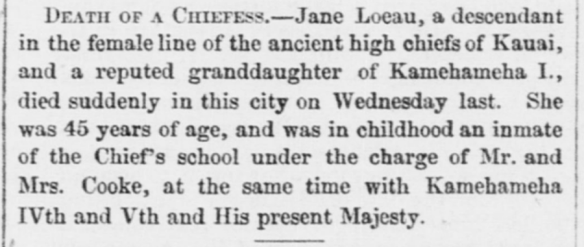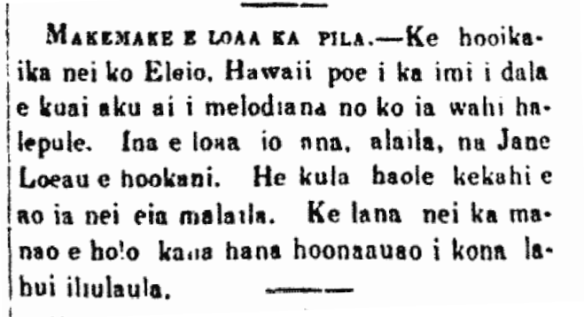A History of Jane Loeau.
In the year 1847, Jane Loeau was boarding at the school of Mr. and Mrs. Cooke [Kuke], and she married John Robert Jasper [Keoki-pu], and he died. In the year 1855 perhaps, she married Marvin Seger [Sika] [? Martin Seger], and he died. In the year 1862, she married me. We were together for 10 years, 7 months, and 25 days in the covenant of marriage in peace and happiness. We did not leave one another, but it was the angel of heaven who has separated us, and I live with sadness and never-ending regret.
She is one of the royal descendants of Hawaii nei, born of alii “Papa.” From ancient times, her rank was of royalty, but she humbled herself, befriended and warmly welcomed newcomers, she was loving, and she was kind in actions and words, and she was a follower of the Lord. In the year 1865, she joined the church at West Hamakua, Hawaii, and this past July, the Rev. J. Bicknell [Bikanele] released our covenant at Kawaiahao Church, to Rev. H. H. Parker [Paleka] [? ua hookuu mai la o Rev. J. Bikanele i ko maua berita ma ka ekalesia o Kawaiahao, ia Rev. H. H. Paleka.]. “Blessed are those who die in the Lord.” I composed this loving chant [kanaenae] for her below:
Ke aoa lani ulu haoa o ke kapu,
Ke aoa lani o Haholua o Palena,
O ke Kihenelani nei a Kauhi—e,
Na Kauhikealani o Kama,
Oia no—a.
Ka Punua ula ku i ka moku,
I hoopunanaia iloko o ka lani,
O ka lani me he aka la i ka wai,
He akamai i ke kui lani,
Kuiia ae kani kui hono i ka moku,
Ka mai kaupoa ma ke kua,
I ku ka hene ma ka houpo,
Poaha ia hemo ka Haku,
Ma ka manawa o ka ua kapu,
O Holani nui kaipo,
Ma ka loko mai o Holani na ‘lii,
Oia no—a.
Hoopuka i Nuuanu ka ua a ka makani,
Haiki ka pili hau i Kahaukomo,
Komo i na kiowai a ke Kiowao,
Aleale i ke alo ua o Lanihuli,
Hala i ka na’ki o Konahuanui,
Nui ka ua, mahimahi nui ka makani,
Na hookoikoi a ka waahia,
He hilahila oe ke hai mai—e,
Iini ana loko,
Oia no—a.
O Hanalei ua pehu ka lani,
Pohu ka lani, loloa ka opua,
Opua lani uli ku hakakai,
Kai ka ua e—e ua i ka liko,
A ka liko awe loloa ka ua iluna,
Lele pulelo iluna o ka lau o ka laau,
Ukuhi i na pakeke wai o Neki,
Piha Hilo ke kaheka kulu a ka wai,
Wahiaia aku la Waioli e ka ua,
Naha Hanalei ke kahe nei ke one,
Oia ua e—e ua i Hanalei,
Oia no—a.
Hanalei lani kupilikii, kupilikii mau a ka lani,
Huikau ae la he hooilo, mahiki mai la ka lehua,
Ka lehua hale, ka lehua makanoe,
Ka naele i o ia e ka wai ka lepo,
O Hiku iluna o Maunahina,
Kupeke, kapekepeke iluna o Hauai’liki,
Iliki ka noe, anu ka nahele,
He nahele anu, me ua hoa’la i na lae ino o ka moe,
E poi ana a ku he ‘hu,
Moe aku ka luhi i Kauakanana—e,
E hoonana ae ana i ka moe—e,
O oni mai auanei ma ka hope,
Mahope mai—a,
Oia no—a.
(To be continued.)
S. L. Kaelemakule.
Honolulu, August 6, 1873.
[I am not sure if there is a continuation to this.
S. L. Kaelemakule doesn’t live that many years after that. He dies on March 3, 1878, at Kepahoni, Honolulu.]
(Ko Hawaii Ponoi, 8/13/1873, p. 4)

Ko Hawaii Ponoi, Buke I, Helu 9, Aoao 4. Augate 13, 1873.








